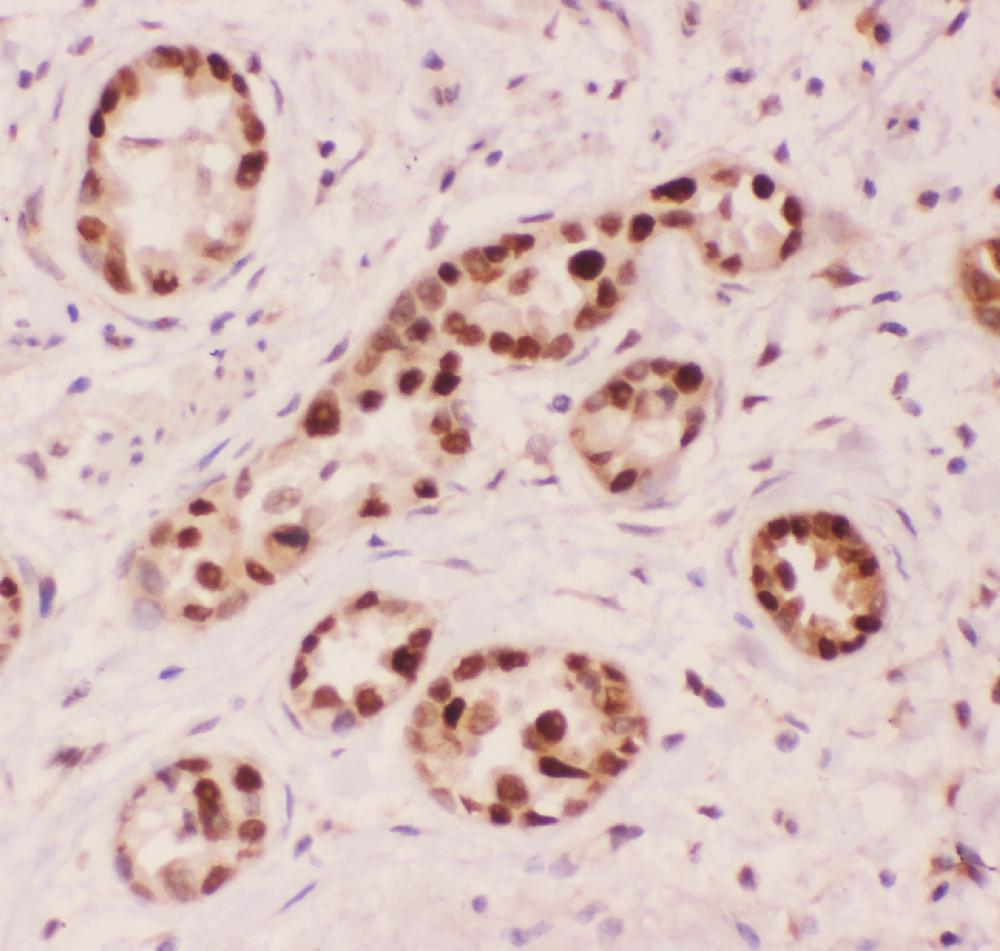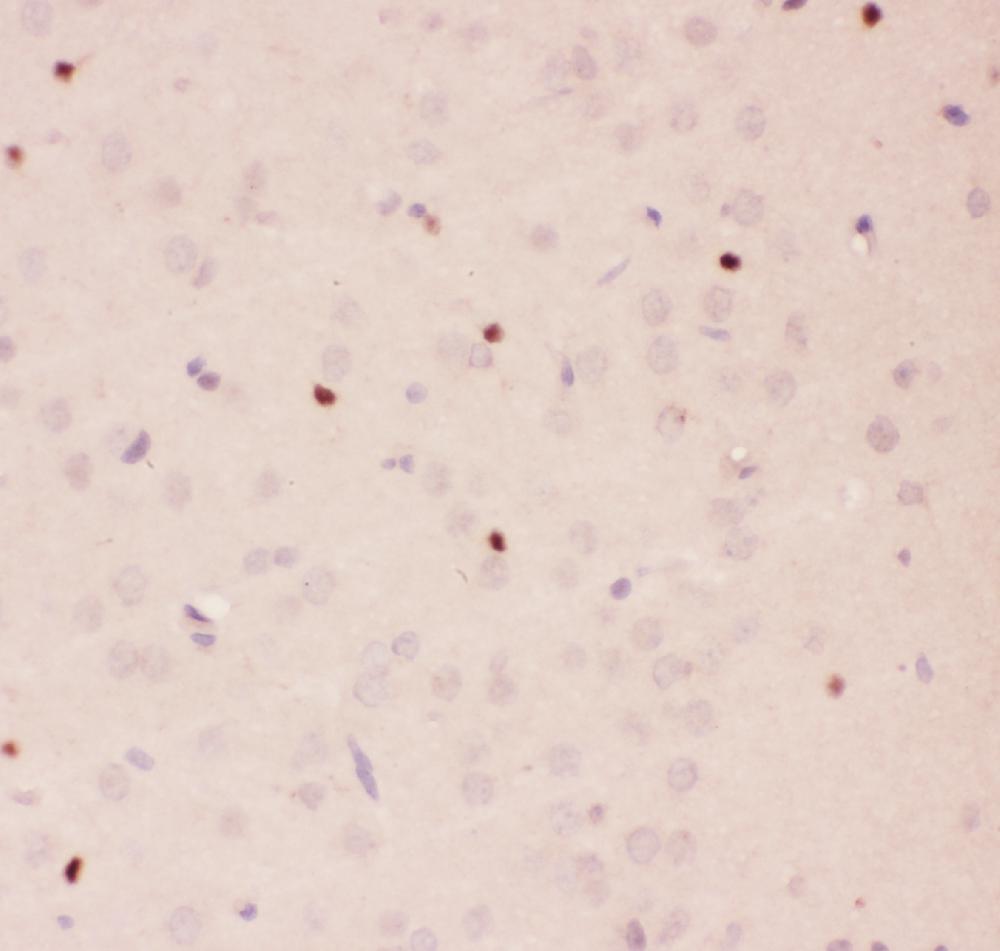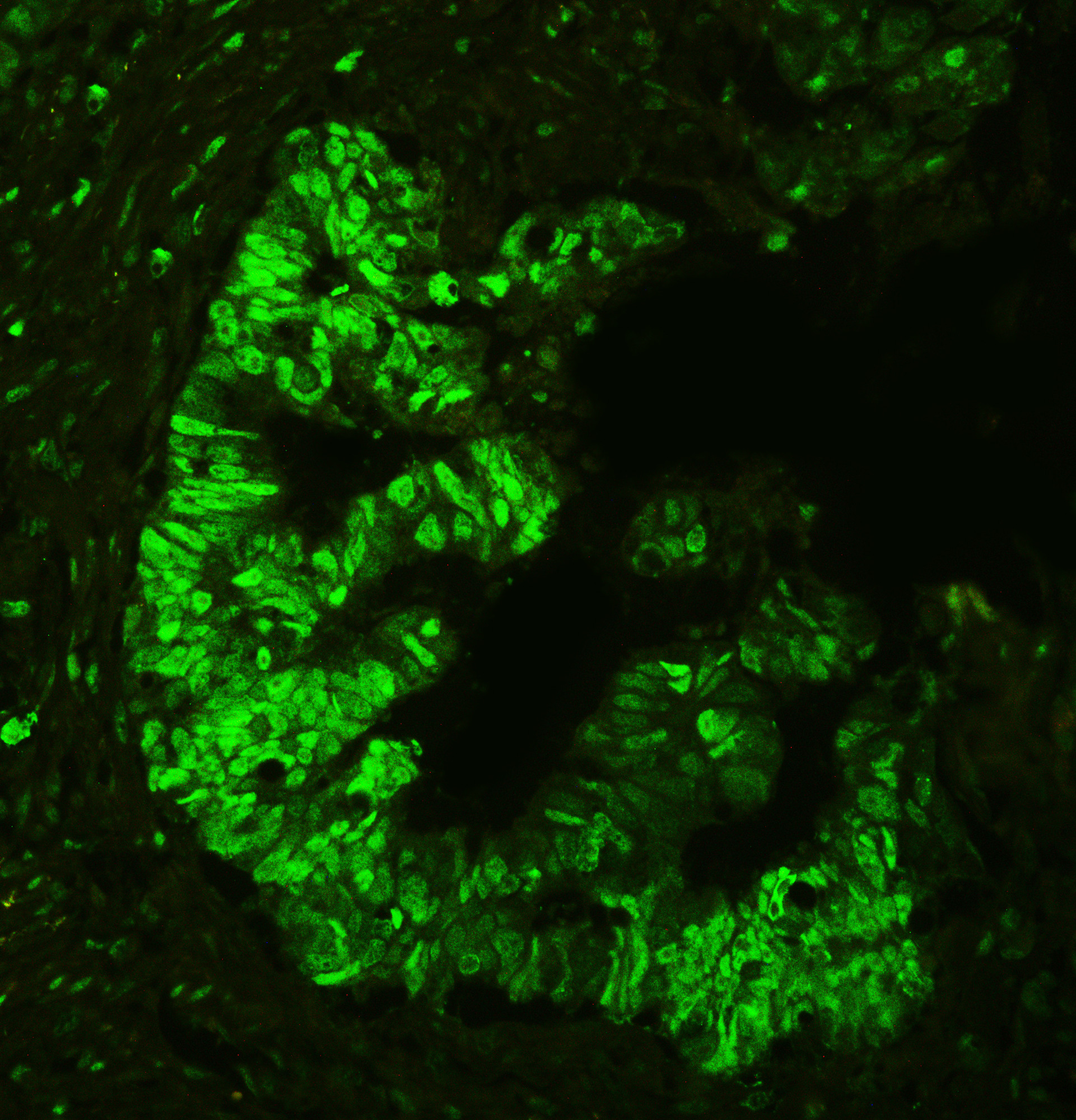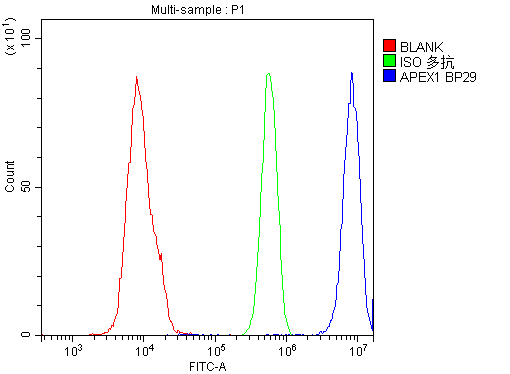| Western blot (WB): | 1:500-2000 |
| Immunohistochemistry (IHC): | 1:50-400 |
| Immunofluorescence (IF): | 1:50-400 |
| Immunocytochemistry/Immunofluorescence (ICC/IF): | 1:50-400 |
| Flow Cytometry (Fixed): | 1:50-200 |
| (Boiling the paraffin sections in 10mM citrate buffer,pH6.0,or PH8.0 EDTA repair liquid for 20 mins is required for the staining of formalin/paraffin sections.) Optimal working dilutions must be determined by end user. | |

Western blot analysis of APEX1 using anti-APEX1 antibody (PB9128). The sample well of each lane was loaded with 30 ug of sample under reducing conditions.
Lane 1: human K562 whole cell lysates,
Lane 2: human HepG2 whole cell lysates,
Lane 3: human Raji whole cell lysates,
Lane 4: human A431 whole cell lysates,
Lane 5: human A549 whole cell lysates,
Lane 6: human MCF-7 whole cell lysates,
Lane 7: human RT4 whole cell lysates,
Lane 8: human U87 whole cell lysates.
After electrophoresis, proteins were transferred to a membrane. Then the membrane was incubated with rabbit anti-APEX1 antigen affinity purified polyclonal antibody (PB9128) at a dilution of 1:1000 and probed with a DyLight 647 Conjugated AffiniPure Goat Anti-rabbit IgG (H+L) secondary antibody (Catalog # BA1150). A specific band was detected for APEX1 at approximately 36 kDa. The expected band size for APEX1 is at 36 kDa.

Western blot analysis of APEX1 using anti-APEX1 antibody (PB9128). The sample well of each lane was loaded with 30 ug of sample under reducing conditions.
Lane 1: human K562 whole cell lysates,
Lane 2: human HepG2 whole cell lysates,
Lane 3: human Raji whole cell lysates,
Lane 4: human A431 whole cell lysates,
Lane 5: human A549 whole cell lysates,
Lane 6: human MCF-7 whole cell lysates,
Lane 7: human RT4 whole cell lysates,
Lane 8: human U87 whole cell lysates.
After electrophoresis, proteins were transferred to a membrane. Then the membrane was incubated with rabbit anti-APEX1 antigen affinity purified polyclonal antibody (PB9128) at a dilution of 1:1000 and probed with a DyLight 647 Conjugated AffiniPure Goat Anti-rabbit IgG (H+L) secondary antibody (Catalog # BA1150). A specific band was detected for APEX1 at approximately 36 kDa. The expected band size for APEX1 is at 36 kDa.

IHC analysis of APEX1 using anti-APEX1 antibody (PB9128).
APEX1 was detected in a paraffin-embedded section of human lung cancer tissue. Biotinylated goat anti-rabbit IgG was used as secondary antibody. The tissue section was incubated with rabbit anti-APEX1 Antibody (PB9128) at a dilution of 1:200 and developed using Strepavidin-Biotin-Complex (SABC) (Catalog # SA1022) with DAB (Catalog # AR1027) as the chromogen.

IHC analysis of APEX1 using anti-APEX1 antibody (PB9128).
APEX1 was detected in a paraffin-embedded section of mouse brain tissue. Biotinylated goat anti-rabbit IgG was used as secondary antibody. The tissue section was incubated with rabbit anti-APEX1 Antibody (PB9128) at a dilution of 1:200 and developed using Strepavidin-Biotin-Complex (SABC) (Catalog # SA1022) with DAB (Catalog # AR1027) as the chromogen.

IHC analysis of APEX1 using anti-APEX1 antibody (PB9128).
APEX1 was detected in a paraffin-embedded section of rat brain tissue. Biotinylated goat anti-rabbit IgG was used as secondary antibody. The tissue section was incubated with rabbit anti-APEX1 Antibody (PB9128) at a dilution of 1:200 and developed using Strepavidin-Biotin-Complex (SABC) (Catalog # SA1022) with DAB (Catalog # AR1027) as the chromogen.

IF analysis of APEX1 using anti-APEX1 antibody (PB9128).
APEX1 was detected in an immunocytochemical section of U2OS cells. The section was incubated with rabbit anti-APEX1 Antibody (PB9128) at a dilution of 1:100. DyLight®488 Conjugated Goat Anti-Rabbit IgG (Green) (Catalog # BA1127) was used as secondary antibody. The section was counterstained with DAPI (Catalog # AR1176) (Blue).

IF analysis using anti- APEX1 antibody (PB9128). detected in paraffin-embedded section of human colon cancer tissue. The tissue section were stained using the Dylight488-conjugated Anti-rabbit IgG Secondary Antibody (green) (Catalog # BA1127) and counterstained with DAPI (blue).

Flow Cytometry analysis of U937 cells using anti-APEX1 antibody (PB9128).
Overlay histogram showing U937 cells stained with PB9128 (Blue line). To facilitate intracellular staining, cells were fixed with 4% paraformaldehyde and permeabilized with permeabilization buffer. The cells were blocked with 10% normal goat serum. And then incubated with rabbit anti-APEX1 Antibody (PB9128) at 1:100 dilution for 30 min at 20°C. DyLight®488 conjugated goat anti-rabbit IgG (BA1127) was used as secondary antibody at 1:100 dilution for 30 minutes at 20°C. Isotype control antibody (Green line) was rabbit IgG at 1:100 dilution used under the same conditions. Unlabelled sample without incubation with primary antibody and secondary antibody (Red line) was used as a blank control.

Western blot analysis of APEX1 using anti-APEX1 antibody (PB9128). The sample well of each lane was loaded with 30 ug of sample under reducing conditions.
Lane 1: human K562 whole cell lysates,
Lane 2: human HepG2 whole cell lysates,
Lane 3: human Raji whole cell lysates,
Lane 4: human A431 whole cell lysates,
Lane 5: human A549 whole cell lysates,
Lane 6: human MCF-7 whole cell lysates,
Lane 7: human RT4 whole cell lysates,
Lane 8: human U87 whole cell lysates.
After electrophoresis, proteins were transferred to a membrane. Then the membrane was incubated with rabbit anti-APEX1 antigen affinity purified polyclonal antibody (PB9128) at a dilution of 1:1000 and probed with a DyLight 647 Conjugated AffiniPure Goat Anti-rabbit IgG (H+L) secondary antibody (Catalog # BA1150). A specific band was detected for APEX1 at approximately 36 kDa. The expected band size for APEX1 is at 36 kDa.

Western blot analysis of APEX1 using anti-APEX1 antibody (PB9128). The sample well of each lane was loaded with 30 ug of sample under reducing conditions.
Lane 1: human K562 whole cell lysates,
Lane 2: human HepG2 whole cell lysates,
Lane 3: human Raji whole cell lysates,
Lane 4: human A431 whole cell lysates,
Lane 5: human A549 whole cell lysates,
Lane 6: human MCF-7 whole cell lysates,
Lane 7: human RT4 whole cell lysates,
Lane 8: human U87 whole cell lysates.
After electrophoresis, proteins were transferred to a membrane. Then the membrane was incubated with rabbit anti-APEX1 antigen affinity purified polyclonal antibody (PB9128) at a dilution of 1:1000 and probed with a DyLight 647 Conjugated AffiniPure Goat Anti-rabbit IgG (H+L) secondary antibody (Catalog # BA1150). A specific band was detected for APEX1 at approximately 36 kDa. The expected band size for APEX1 is at 36 kDa.

IHC analysis of APEX1 using anti-APEX1 antibody (PB9128).
APEX1 was detected in a paraffin-embedded section of human lung cancer tissue. Biotinylated goat anti-rabbit IgG was used as secondary antibody. The tissue section was incubated with rabbit anti-APEX1 Antibody (PB9128) at a dilution of 1:200 and developed using Strepavidin-Biotin-Complex (SABC) (Catalog # SA1022) with DAB (Catalog # AR1027) as the chromogen.

IHC analysis of APEX1 using anti-APEX1 antibody (PB9128).
APEX1 was detected in a paraffin-embedded section of mouse brain tissue. Biotinylated goat anti-rabbit IgG was used as secondary antibody. The tissue section was incubated with rabbit anti-APEX1 Antibody (PB9128) at a dilution of 1:200 and developed using Strepavidin-Biotin-Complex (SABC) (Catalog # SA1022) with DAB (Catalog # AR1027) as the chromogen.

IHC analysis of APEX1 using anti-APEX1 antibody (PB9128).
APEX1 was detected in a paraffin-embedded section of rat brain tissue. Biotinylated goat anti-rabbit IgG was used as secondary antibody. The tissue section was incubated with rabbit anti-APEX1 Antibody (PB9128) at a dilution of 1:200 and developed using Strepavidin-Biotin-Complex (SABC) (Catalog # SA1022) with DAB (Catalog # AR1027) as the chromogen.

IF analysis of APEX1 using anti-APEX1 antibody (PB9128).
APEX1 was detected in an immunocytochemical section of U2OS cells. The section was incubated with rabbit anti-APEX1 Antibody (PB9128) at a dilution of 1:100. DyLight®488 Conjugated Goat Anti-Rabbit IgG (Green) (Catalog # BA1127) was used as secondary antibody. The section was counterstained with DAPI (Catalog # AR1176) (Blue).

IF analysis using anti- APEX1 antibody (PB9128). detected in paraffin-embedded section of human colon cancer tissue. The tissue section were stained using the Dylight488-conjugated Anti-rabbit IgG Secondary Antibody (green) (Catalog # BA1127) and counterstained with DAPI (blue).

Flow Cytometry analysis of U937 cells using anti-APEX1 antibody (PB9128).
Overlay histogram showing U937 cells stained with PB9128 (Blue line). To facilitate intracellular staining, cells were fixed with 4% paraformaldehyde and permeabilized with permeabilization buffer. The cells were blocked with 10% normal goat serum. And then incubated with rabbit anti-APEX1 Antibody (PB9128) at 1:100 dilution for 30 min at 20°C. DyLight®488 conjugated goat anti-rabbit IgG (BA1127) was used as secondary antibody at 1:100 dilution for 30 minutes at 20°C. Isotype control antibody (Green line) was rabbit IgG at 1:100 dilution used under the same conditions. Unlabelled sample without incubation with primary antibody and secondary antibody (Red line) was used as a blank control.







